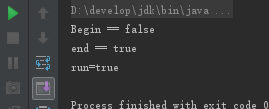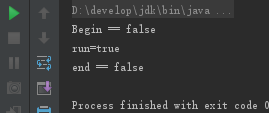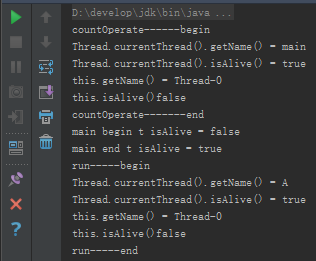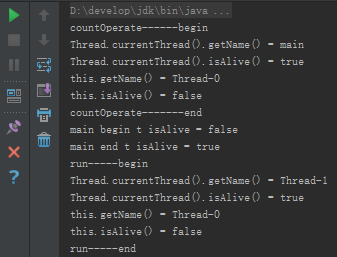1.4 isAlive()方法
方法isAlive()是判断当前线程是否处于活动状态。
线程代码:
public class TestThread extends Thread{
@Override
public void run() {
System.out.println("run=" + this.isAlive());
}
}
运行代码:
public class Main {
public static void main(String[] args) {
TestThread tt = new TestThread();
System.out.println("Begin == " + tt.isAlive());
tt.start();
//这行代码的结果是不确定的,打印true表示tt线程还未执行完毕,打印false表示tt线程已经执行完毕。下面会给出结果为false的情况
System.out.println("end == " + tt.isAlive());
}
}
运行结果:

方法isAlive()是测试线程是否处于活跃状态的方法,
活跃状态:线程已经启动且尚未终止。线程处于正在运行或准备开始运行的状态,就认为线程是“存活的”。
结果为false的执行代码:
public class Main { public static void main(String[] args) { try { TestThread tt = new TestThread(); System.out.println("Begin == " + tt.isAlive()); tt.start(); //通过这行代码使当前线程睡眠,让tt线程完成并结束 Thread.sleep(1000); System.out.println("end == " + tt.isAlive()); } catch (Exception e) { e.printStackTrace(); } } }
执行结果:

在使用isAlive()方法时,如果将线程对象以构造参数的方式传递给Thread对象进行start()启动时,运行的结果和前面会有差异。产生差异的原因在于:Thread.currentThread()和this的差异。
测试线程代码:
public class countOperate extends Thread {
public countOperate() {
System.out.println("countOperate------begin");
System.out.println("Thread.currentThread().getName() = " + Thread.currentThread().getName());
System.out.println("Thread.currentThread().isAlive() = " + Thread.currentThread().isAlive());
System.out.println("this.getName() = " + this.getName());
System.out.println("this.isAlive() = " + this.isAlive());
System.out.println("countOperate-------end");
}
@Override
public void run() {
System.out.println("run-----begin");
System.out.println("Thread.currentThread().getName() = " + Thread.currentThread().getName());
System.out.println("Thread.currentThread().isAlive() = " + Thread.currentThread().isAlive());
System.out.println("this.getName() = " + this.getName());
System.out.println("this.isAlive()" + this.isAlive());
System.out.println("run-----end");
}
}
执行代码:
public class Main {
public static void main(String[] args) {
countOperate co = new countOperate();
Thread t = new Thread(co);
System.out.println("main begin t isAlive = " + t.isAlive());
t.setName("A");
t.start();
System.out.println("main end t isAlive = " + t.isAlive());
}
}
执行结果:

最后这个运行结果, 真的是惊了。我觉得run里面的this.isAlive()应该为true的,我认为this指代的就是开启的另一条线程,而main跟a其实都是主线程。后来发现不太对:
修改执行代码:
public class Main {
public static void main(String[] args) {
countOperate co = new countOperate();
Thread t = new Thread(co);
System.out.println("main begin t isAlive = " + t.isAlive());
//t.setName("A");
t.start();
System.out.println("main end t isAlive = " + t.isAlive());
}
}
执行结果:

然后我思考了一下:在个人的见解上认为了Thread.currentThread()获取的线程与this的线程的区别。
Thread.currentThread()获取的为当前运行的线程
注:(在完成CountOperate的构造方法时,运行的是主线程,在调用start()时运行的是t线程。)。
this获取的为当前所在的线程
注:(所以不论是构造方法中还是run方法中他都位于同一个线程,且这个线程从头到尾都没有被开启)。
源码地址:https://github.com/lilinzhiyu/threadLearning
本文内容是书中内容兼具自己的个人看法所成。可能在个人看法上会有诸多问题(毕竟知识量有限,导致认知也有限),如果读者觉得有问题请大胆提出,我们可以相互交流、相互学习,欢迎你们的到来,心成意足,等待您的评价。




